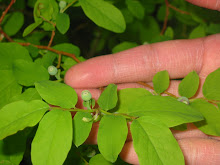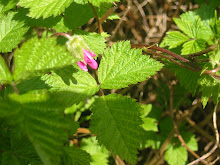This frog was right beside a group of us removing stumps and salal in the NW corner of the bog!
Sunday, February 28, 2016
Sunday, February 21, 2016
Summary of a Lichen study conducted by IB student Hannah Liu
My interest in bogs began when I started volunteering for the Camosun Bog Restoration Project three years ago. The opportunity to work with unique plants such as the colourful varieties of sphagnum moss, the keystone species, grabbed my attention. Last year, the restoration leader Gerry Mignault alerted me to the presence of a layer of green algae and some white mushrooms spreading over sphagnum which appeared to be dead or severely stressed. After consulting Shona Ellis and Frank Skelton, the presence of a lichen called Lichenomphalia umbellifera was confirmed. I proceeded to do some microscopy at UBC under the supervision of Dr. Brett Couch to see how the lichen interacts with sphagnum moss. I was intrigued by what I saw under the microscope, and decided to proceed with a more detailed study to see if this lichen grew in peat conditions unfavourable for sphagnum moss (higher nutrient, basic pH). I collected samples of sphagnum moss and peat from Camosun Bog, with and without L. umbellifera, to compare the nutrients levels and pH. I found elevated levels of potassium and phosphorus in the samples with L. umbellifera, but no notable difference in nitrogen or pH between the samples. More data is needed to confirm the results, but perhaps the extensive presence of L. umbellifera can be used as an indicator of higher than normal phosphorus and potassium levels. Many lichens are sensitive to environmental changes such as increasing air pollution, so they are used as biological indicators for monitoring air quality. Similarly, the recent problem in Camosun Bog of patches of sphagnum dying could be caused by ecological changes in peat nutrient content from both natural (ex. animal feces) and human causes (ex.fertilizers). Therefore the recent spread of L. umbellifera could be an indication of changing conditions in the bog. I believe that the Camosun Bog Restoration Group could benefit from studying potential indicator species such as this lichen. Methods of bioremediation could be introduced based on balancing peat conditions using various planting methods and introducing particular species.
Read about the study here: The growth of Lichenomphalia Umbelliferain Camosun Bog as an indicator of nitrogen, phosphorus, potassium, and pH conditions, By Hannah Liu, IB Candidate
Read about the study here: The growth of Lichenomphalia Umbelliferain Camosun Bog as an indicator of nitrogen, phosphorus, potassium, and pH conditions, By Hannah Liu, IB Candidate
Photo Description: Lichenomphalia umbellifera growing on degraded sphagnum
Saturday, February 20, 2016
Removing salal
Salal is a native forest plant, but in our bog, it adds unwanted nutrients. Today the crazy Boggers removed it from the north west corner of the bog.
Tuesday, February 16, 2016
Subscribe to:
Posts (Atom)




























